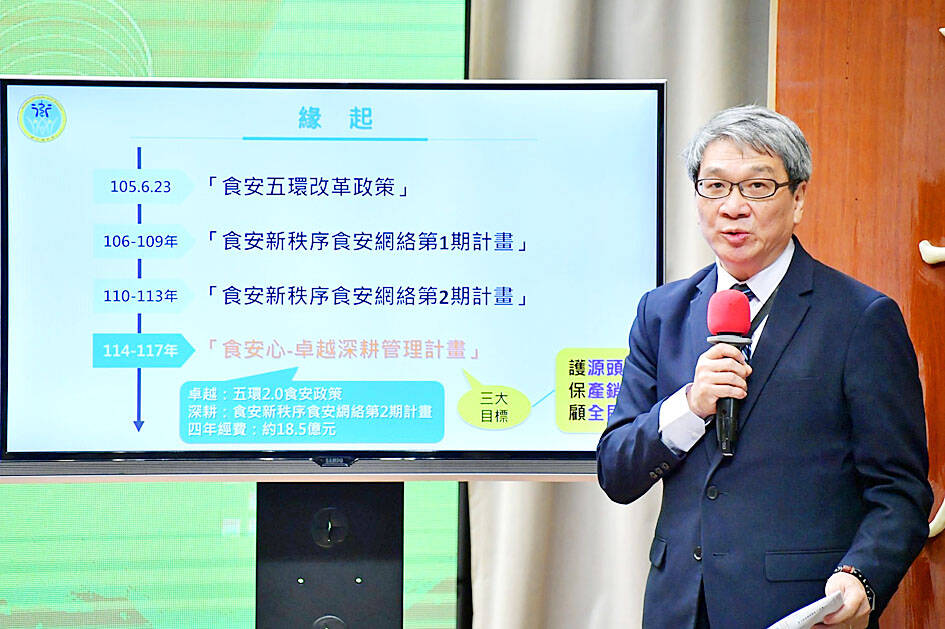The Ministry of Health and Welfare yesterday announced that it would spend NT$1.85 billion (US$57.66 million) over the next four years on improving food safety, most notably by expanding the use of artificial intelligence (AI).
The ministry at a Cabinet meeting briefed Premier Cho Jung-tai (卓榮泰) on its AI-enhanced food safety plans focusing on three key areas: food source risk management, chain of custody certification and community monitoring.
The Executive Yuan approved the new food safety management plan in August, the ministry said.

Photo courtesy of the Executive Yuan
Food safety is central to the government’s agenda, Cabinet spokeswoman Michelle Lee (李慧芝) quoted Cho as saying during the meeting, as he urged the ministry to carefully carry out the initiative.
The plan requires a budget increase of about 73 percent from NT$186.2 million this year to NT$321.4 million next year, a NT$135.1 million difference, Lee cited Cho as saying.
The policy is part of a broader agenda termed the “five strikes and seven safeties,” which refer to five types of crime — organized, financial, gun, drug and fraud — the government wants to tackle, and seven safety issues — public, food, road, occupational, school, housing and cybersecurity — that the ministry is to uphold, she said.
The project uses AI and digital technology to promote four key tasks: export development; improved management of specific industries such as cold chain storage; monitoring of heavy metals in food products; and analysis of international food advertising regulations, the ministry said.
AI would also be used to optimize risk management and early warning mechanisms for food safety incidents, in addition to providing services for the public and regulating food advertisements, it said.
The Food and Drug Administration (FDA) said it would continue to improve its food safety management policies, including enhancing cooperation with local officials on food inspections, increasing its capacity for inspections, refining management of imported food sources and expanding its international food risk alert monitoring.
The FDA said it would also coordinate cross-ministerial inspections to support digital initiatives, and reinforce food safety and hygiene precautions.

Taiwanese scientists have engineered plants that can capture about 50 percent more carbon dioxide and produce more than twice as many seeds as unmodified plants, a breakthrough they hope could one day help mitigate global warming and grow more food staples such as rice. If applied to major food crops, the new system could cut carbon emissions and raise yields “without additional equipment or labor costs,” Academia Sinica researcher and lead author the study Lu Kuan-jen (呂冠箴) said. Academia Sinica president James Liao (廖俊智) said that as humans emit 9.6 billion tonnes of carbon dioxide compared with the 220 billion tonnes absorbed

The Taipei Mass Rapid Transit (MRT) Wanda-Zhonghe Line is 81.7 percent complete, with public opening targeted for the end of 2027, New Taipei City Mayor Hou You-yi (侯友宜) said today. Surrounding roads are to be open to the public by the end of next year, Hou said during an inspection of construction progress. The 9.5km line, featuring nine underground stations and one depot, is expected to connect Chiang Kai-shek Memorial Hall Station to Chukuang Station in New Taipei City’s Jhonghe District (中和). All 18 tunnels for the line are complete, while the main structures of the stations and depot are mostly finished, he

Taipei is to implement widespread road closures around Taipei 101 on Friday to make way for large crowds during the Double Ten National Day celebration, the Taipei Department of Transportation said. A four-minute fireworks display is to be launched from the skyscraper, along with a performance by 500 drones flying in formation above the nearby Nanshan A21 site, starting at 10pm. Vehicle restrictions would occur in phases, they said. From 5pm to 9pm, inner lanes of Songshou Road between Taipei City Hall and Taipei 101 are to be closed, with only the outer lanes remaining open. Between 9pm and 9:40pm, the section is

China’s plan to deploy a new hypersonic ballistic missile at a Chinese People’s Liberation Army Rocket Force (PLARF) base near Taiwan likely targets US airbases and ships in the western Pacific, but it would also present new threats to Taiwan, defense experts said. The New York Times — citing a US Department of Defense report from last year on China’s military power — on Monday reported in an article titled “The missiles threatening Taiwan” that China has stockpiled 3,500 missiles, 1.5 times more than four years earlier. Although it is unclear how many of those missiles were targeting Taiwan, the newspaper reported